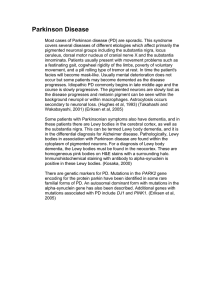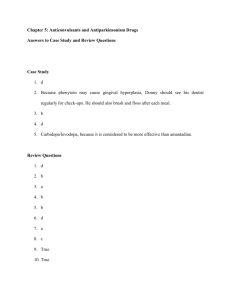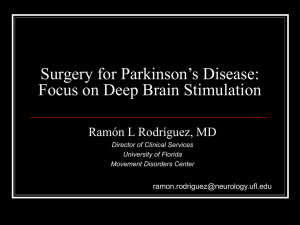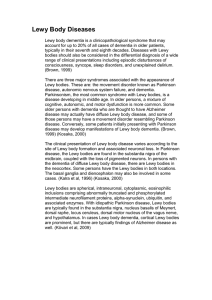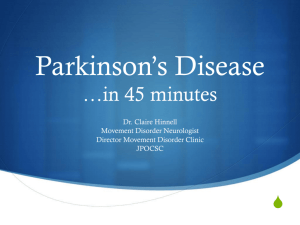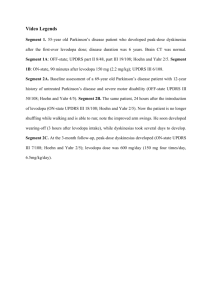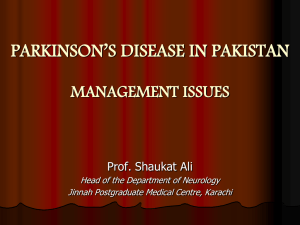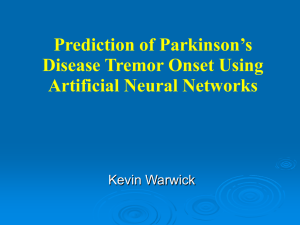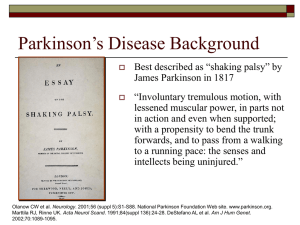Parkinson`s Disease
advertisement
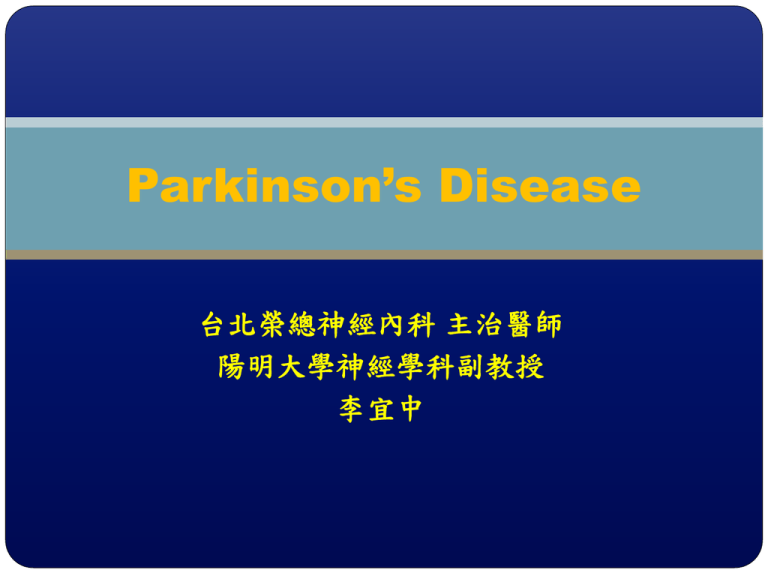
Parkinson’s Disease 台北榮總神經內科 主治醫師 陽明大學神經學科副教授 李宜中 History The disease was first described in 1817 by James Parkinson Clinical Diagnosis Of PD Resting tremor Rigidity Bradykinesia Posture instability 2 of 4 major signs Stages of Parkinson's disease Stage I (mild or early disease): unilateral involved. Stage II: Both sides of the body are affected. Stage III (moderate disease): Both sides involved with postural instability. Stage IV (advanced disease): requiring substantial help in walking and turning. Stage V (severe): Restricted to a bed or chair. Epidemiology of PD The most common movement disorder affecting 1-2 % of the general population over the age of 65 years. The second most common neurodegenerative disorder after Alzheimer´s disease (AD). Prevalence rates in men are slightly higher than in women; reason unknown, though a role for estrogen has been debated. Risk factors of PD Age - the most important risk factor Positive family history Male gender Environmental exposure: Herbicide and pesticide exposure, metals (manganese, iron), well water, farming, rural residence, wood pulp mills; and steel alloy industries Race Life experiences (trauma, emotional stress, personality traits such as shyness and depressiveness)? An inverse correlation between cigarette smoking and caffeine intake in case-control studies. Non-motor features of PD Neuropsycholgochiatric Depression Apathy Sleep disorder Insomnia Daytime sleepiness REM sleep disorders Anxiety Autonomic dysfunction Executive dysfunction dementia Orthostatic hypotension Constipation Urogenital dysfunction Autonomic dysfunction in PD Not only occurs in late stage of PD May as a early sign in AD Medications for PD may exacerbate symptoms of autonomic dysfunction Signs and symptoms of autonomic dysfunction of PD System manifestations Cadiovascular Orthostatic hypotension Gastrointestinal Constipation, dysphagia, diarrhea Urinary bladder Nocturia, frequency, urgency, incontinence, retention Sudomotor ANHIDROSIS, HEAT INTOLERANCE Sexual Erectile and ejaculatory failure Ocular Aniscoria, Horner’s syndrome Respiratory Stridor, apneic episode, inspiratory gasps Pathology of PD Neuropathology of PD Eosinophilic, round intracytoplasmic inclusions called lewy bodies and Lewy neurites. First described in 1912 by a German neuropathologist - Friedrich Lewy. Inclusions particularly numerous in the substantia nigra pars compacta. Lewy bodies Neuropathology of PD: Lewy bodies Not limited to substantia nigra only; also found in the locus coeruleus, motor nucleus of the vagus nerve, the hypothalamus, the nucleus basalis of Meynert, the cerebral cortex, the olfactory bulb and the autonomic nervous system. Confined largely to neurons; glial cells only rarely affected. Functional neuroanatomy of PD Substantia nigra: The major origin of the dopaminergic innervation of the striatum. Part of extrapyramidal system which processes information coming from the cortex to the striatum, returning it back to the cortex through the thalamus. One major function of the striatum is the regulation of posture and muscle tonus. Pathophysiology of PD Secondary parkinsonism 續發性(secondary)巴金森氏症是因一些疾病或物 質造成類似巴金森氏病的症狀,其相關原因可能有 腦炎 腦動脈硬化(cerebral ateriosclerosis):多為老年人。 藥物:reserpine, neuroleptics, metoclopromide, prochloperazine, flunarizine 中毒:一氧化碳、錳、MPTP等。 頭部外傷、職業拳手症 腫瘤 其他神經退化性疾病:如progressive supramuclear palsy, striatonigral degenerateion, Huntington’s disease, Wilson’s disease等。 Pharmacogical mangement Treatment of Parkinson‘s disease in the 1860‘s -Dr. J. M. Charcot‘s Rocking chair Neurochemistry of PD Late 1950s: Dopamine (DA) present in mammalian brain, and the levels highest within the striatum. 1960, Ehringer and Hornykiewicz: The levels of DA severely reduced in the striatum of PD patients. PD symptoms become manifest when about 50-60 % of the DA-containing neurons in the substantia nigra and 70-80 % of striatal DA are lost. Dopamine synthesis Pharmacological treatment of PD 初期使用L-dopa之副作用 腸胃症狀 噁心、腹痛、食慾減退、嘔吐 心臟血管症狀 心悸、暈眩、心律不整、姿勢性低血壓 腦功能症狀 注意力不集中、焦慮、興奮、幻覺、幻想 其他症狀 性慾增加、尿變紅、皮膚疹 長期使用L-dopa之副作用 藥效減低 藥效時間減短 不自主動作 On-off 現象 Long-term complications of levodopa Motor fluctuation • Weaning-off phenomenon • On-off phenomenon Dyskinesia • Chorea • dystonia Flucturations in levodopa treatment Levodopa related motor flucturation Dyskinesia in levodopa treatment Pharmacological treatment of PD Surgical mangement 巴金森氏病的手術治療方式 立體定位手術 神經細胞損害方式 蒼白球燒灼術 視丘燒灼術 視丘下核燒灼術 腦部深層刺激術 蒼白球刺激術 視丘刺激術 視丘下核刺激術 組織植入手術 胚胎移植 腎上腺移植 培養細胞移植 Motor circuitry of basal ganglion Deep brain stimulation Pre-deep brain stimulation Post-Deep brain stimulation Indication of Deep brain stimulation • Advanced Parkinson's disease • Who have shown benefit from levodopa therapy • Whose symptoms are not adequately controlled by medications. • Patients should be carefully screened for other movement disorders, which may not respond to Deep brain stimulation. • Deep brain stimulation has not been shown to improve symptoms that do not respond also to levodopa. Potential surgical risks • Paralysis, coma, death • Intracranial hemorrhage • Leakage of cerebral fluid surrounding the brain • Seizure • Infection • Allergic response to implanted materials • Temporary or permanent neurological complications • Confusion or attention problems • Pain at the surgery sites Side effects of deep brain stimulation • Tingling sensation (paresthesia) • Worsening of symptoms • Speech problems (dysarthria, dysphasia) • Dizziness or lightheadedness (disequilibrium) • Facial and limb muscle weakness or partial • • • • paralysis (paresis) Abnormal, involuntary muscle contractions (dystonia, dyskinesia) Movement problems or reduced coordination Jolting or shocking sensation Numbness (hypoesthesia) Important Points 巴金森氏病的典型症狀為: 手抖、行動緩慢、肢體 僵硬. 巴金森氏病的主要病理變化發生在Substantia nigra. 巴金森氏病與Dopamine 的缺乏相關. Lewy bodies是在巴金森氏病中,發生病理變化的 神經細胞內中所發生的異常蛋白質堆積所形成, 其主要成分為α-synuclein.
